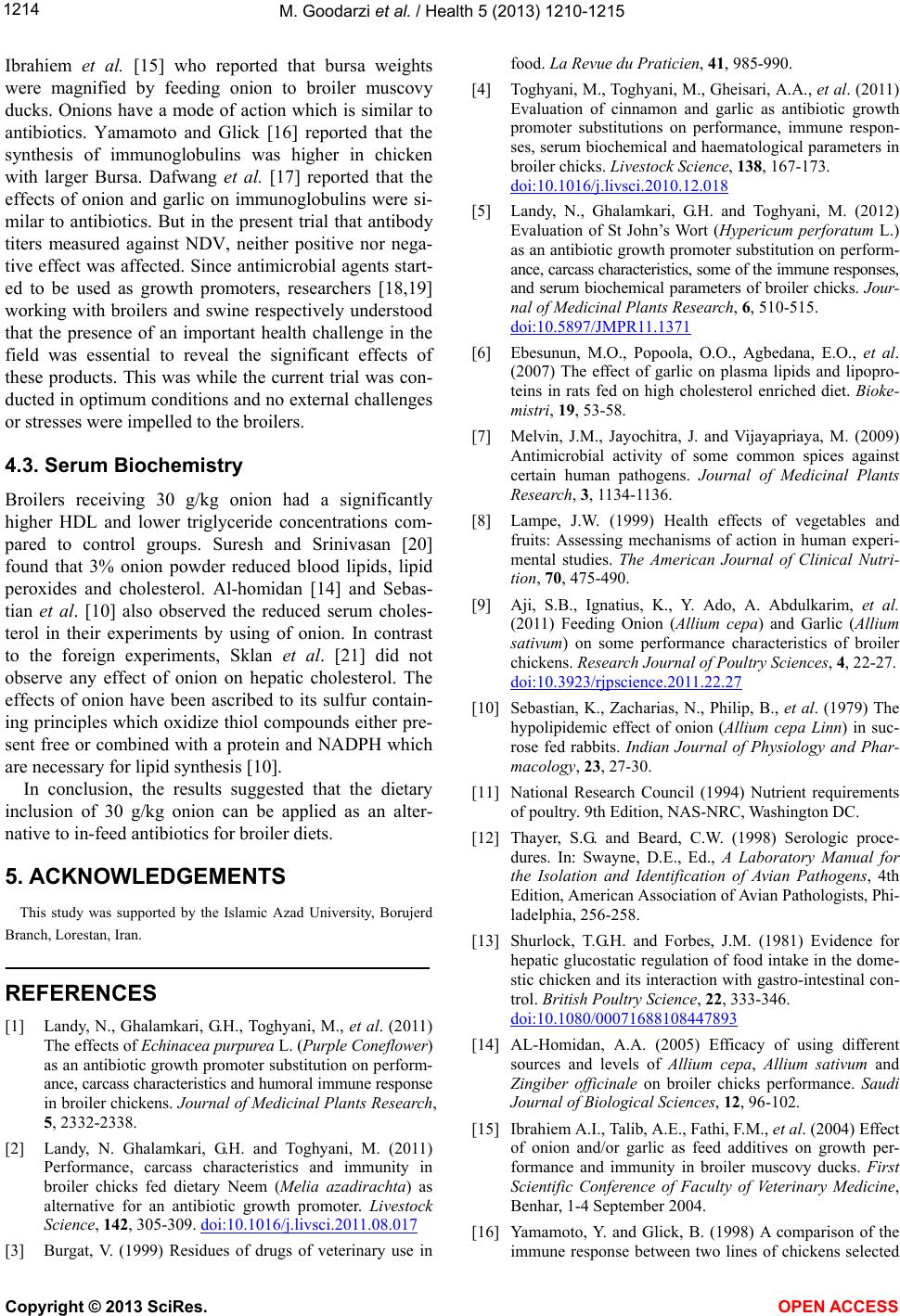
M. Goodarzi et al. / Health 5 (2013) 1210-12 15
1214
Ibrahiem et al. [15] who reported that bursa weights
were magnified by feeding onion to broiler muscovy
ducks. Onions have a mode of action which is similar to
antibiotics. Yamamoto and Glick [16] reported that the
synthesis of immunoglobulins was higher in chicken
with larger Bursa. Dafwang et al. [17] reported that the
effects of onion and garlic on immunoglobulins were si-
milar to antibiotics. But in the present trial that antibody
titers measured against NDV, neither positive nor nega-
tive effect was affected. Since antimicrobial agents start-
ed to be used as growth promoters, researchers [18,19]
working with broilers and swine respectively understood
that the presence of an important health challenge in the
field was essential to reveal the significant effects of
these products. This was while the current trial was con-
ducted in optimum cond itions and no external challeng es
or stresses were impelled to the broilers.
4.3. Serum Biochemistry
Broilers receiving 30 g/kg onion had a significantly
higher HDL and lower triglyceride concentrations com-
pared to control groups. Suresh and Srinivasan [20]
found that 3% onion powder reduced blood lipids, lipid
peroxides and cholesterol. Al-homidan [14] and Sebas-
tian et al. [10] also observed the reduced serum choles-
terol in their experiments by using of onion. In contrast
to the foreign experiments, Sklan et al. [21] did not
observe any effect of onion on hepatic cholesterol. The
effects of onion have been ascribed to its sulfur contain-
ing principles wh ich oxidize thiol compound s either pre-
sent free or combined with a protein and NADPH which
are necessary for lipid synthesis [10].
In conclusion, the results suggested that the dietary
inclusion of 30 g/kg onion can be applied as an alter-
native to in-feed antibio tics for broiler diets.
5. ACKNOWLEDGEMENTS
This study was supported by the Islamic Azad University, Borujerd
Branch, Lorestan, Iran.
REFERENCES
[1] Landy, N., Ghalamkari, G.H., Toghyani, M., et al. (2011)
The effects of Echinacea purpurea L. (Purple Coneflower)
as an antibiotic growth promoter substitution on perform-
ance, carcass characteristics and humoral immune response
in broiler chickens. Journal of Medicinal Plants Research,
5, 2332-2338.
[2] Landy, N. Ghalamkari, G.H. and Toghyani, M. (2011)
Performance, carcass characteristics and immunity in
broiler chicks fed dietary Neem (Melia azadirachta) as
alternative for an antibiotic growth promoter. Livestock
Science, 142, 305-309. doi:10.1016/j.livsci.2011.08.017
[3] Burgat, V. (1999) Residues of drugs of veterinary use in
food. La Revue du Praticien, 41, 985-990.
[4] Toghya ni, M., Toghyani , M., Gheisari, A.A. , et al. (2011)
Evaluation of cinnamon and garlic as antibiotic growth
promoter substitutions on performance, immune respon-
ses, serum biochemical and haematological parameters in
broiler chicks. Livestock Science, 138, 167-173.
doi:10.1016/j.livsci.2010.12.018
[5] Landy, N., Ghalamkari, G.H. and Toghyani, M. (2012)
Evaluation of St John’s Wort (Hypericum perforatum L.)
as an antibiotic growth promoter substitution on perform-
ance, carcass characteri stics, some of the immune responses,
and serum biochemical parameters of broiler chicks. Jour-
nal of Medicinal Plants Research, 6, 510-515.
doi:10.5897/JMPR11.1371
[6] Ebesunun, M.O., Popoola, O.O., Agbedana, E.O., et al.
(2007) The effect of garlic on plasma lipids and lipopro-
teins in rats fed on high cholesterol enriched diet. Bioke-
mistri, 19, 53-58.
[7] Melvin, J.M., Jayochitra, J. and Vijayapriaya, M. (2009)
Antimicrobial activity of some common spices against
certain human pathogens. Journal of Medicinal Plants
Research, 3, 1134-1136.
[8] Lampe, J.W. (1999) Health effects of vegetables and
fruits: Assessing mechanisms of action in human experi-
mental studies. The American Journal of Clinical Nutri-
tion, 70, 475-490.
[9] Aji, S.B., Ignatius, K., Y. Ado, A. Abdulkarim, et al.
(2011) Feeding Onion (Allium cepa) and Garlic (Allium
sativum) on some performance characteristics of broiler
chickens. Research Journal of Poultry Sciences, 4, 22-27.
doi:10.3923/rjpscience.2011.22.27
[10] Sebastian, K., Zacharias, N., Philip, B., et al. (1979) The
hypolipidemic effect of onion (Allium cepa Linn) in suc-
rose fed rabbits. Indian Journal of Physiology and Phar-
macology, 23, 27-30.
[11] National Research Council (1994) Nutrient requirements
of poultry. 9th Edition, NAS-NRC, Washington DC.
[12] Thayer, S.G. and Beard, C.W. (1998) Serologic proce-
dures. In: Swayne, D.E., Ed., A Laboratory Manual for
the Isolation and Identification of Avian Pathogens, 4th
Edition, American Associa tion of Avi an Pathologists , P hi -
ladelphia, 256-258.
[13] Shurlock, T.G.H. and Forbes, J.M. (1981) Evidence for
hepatic glucostatic regulation of food intake in the dome-
stic chicken and its interaction with gastro-intestinal con-
trol. British Poultry Science, 22, 333-346.
doi:10.1080/00071688108447893
[14] AL-Homidan, A.A. (2005) Efficacy of using different
sources and levels of Allium cepa, Allium sativum and
Zingiber officinale on broiler chicks performance. Saudi
Journal of Biological Sciences, 12, 96-102.
[15] Ibrahiem A.I., Talib, A.E., Fathi, F.M., et al. (2004) Effect
of onion and/or garlic as feed additives on growth per-
formance and immunity in broiler muscovy ducks. First
Scientific Conference of Faculty of Veterinary Medicine,
Benhar, 1-4 September 2004.
[16] Yamamoto, Y. and Glick, B. (1998) A comparison of the
immune response between two lines of chickens selected
Copyright © 2013 SciRes. OPEN A CCESS